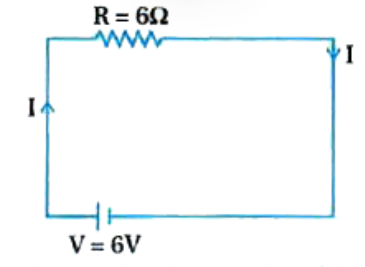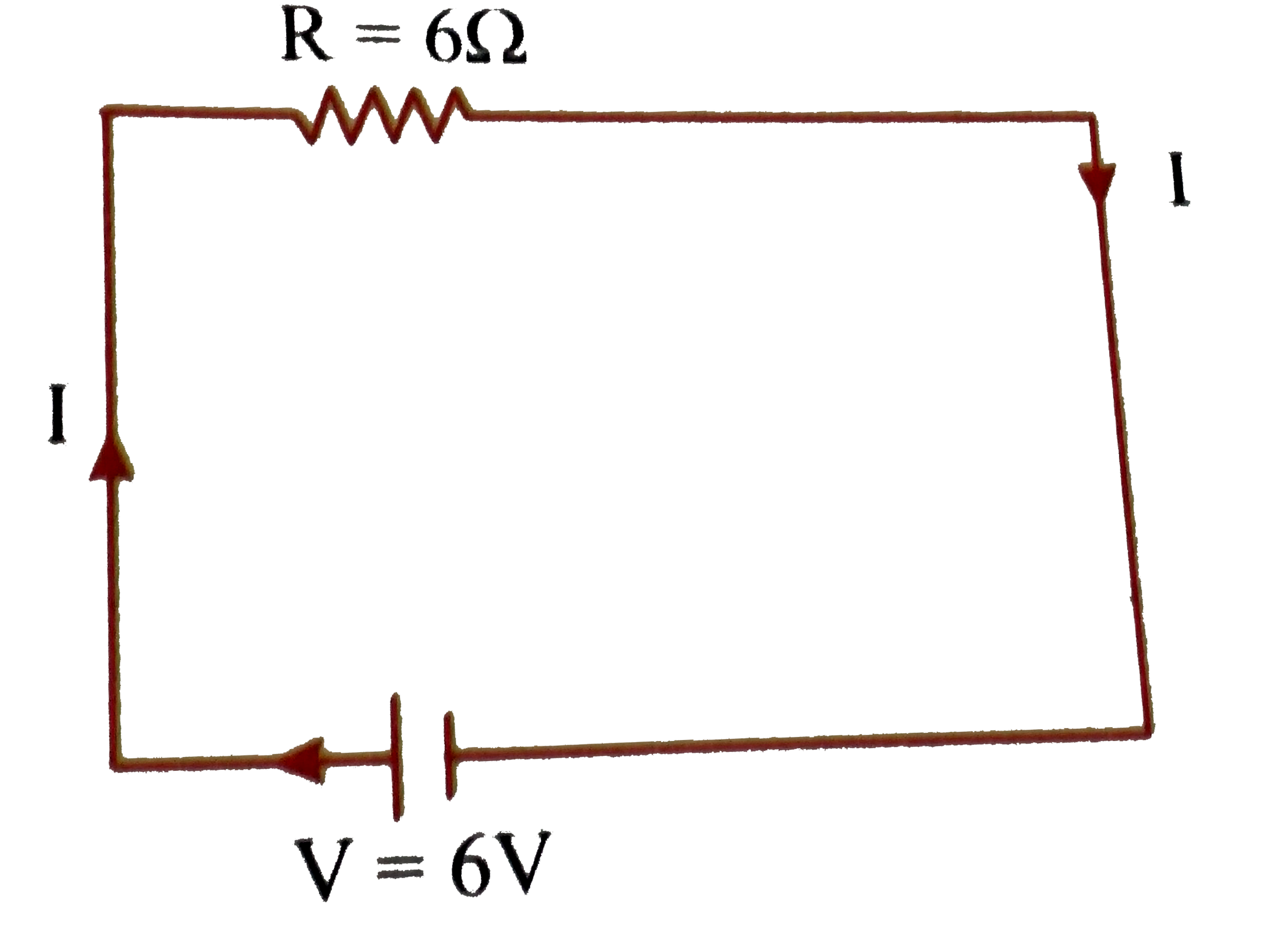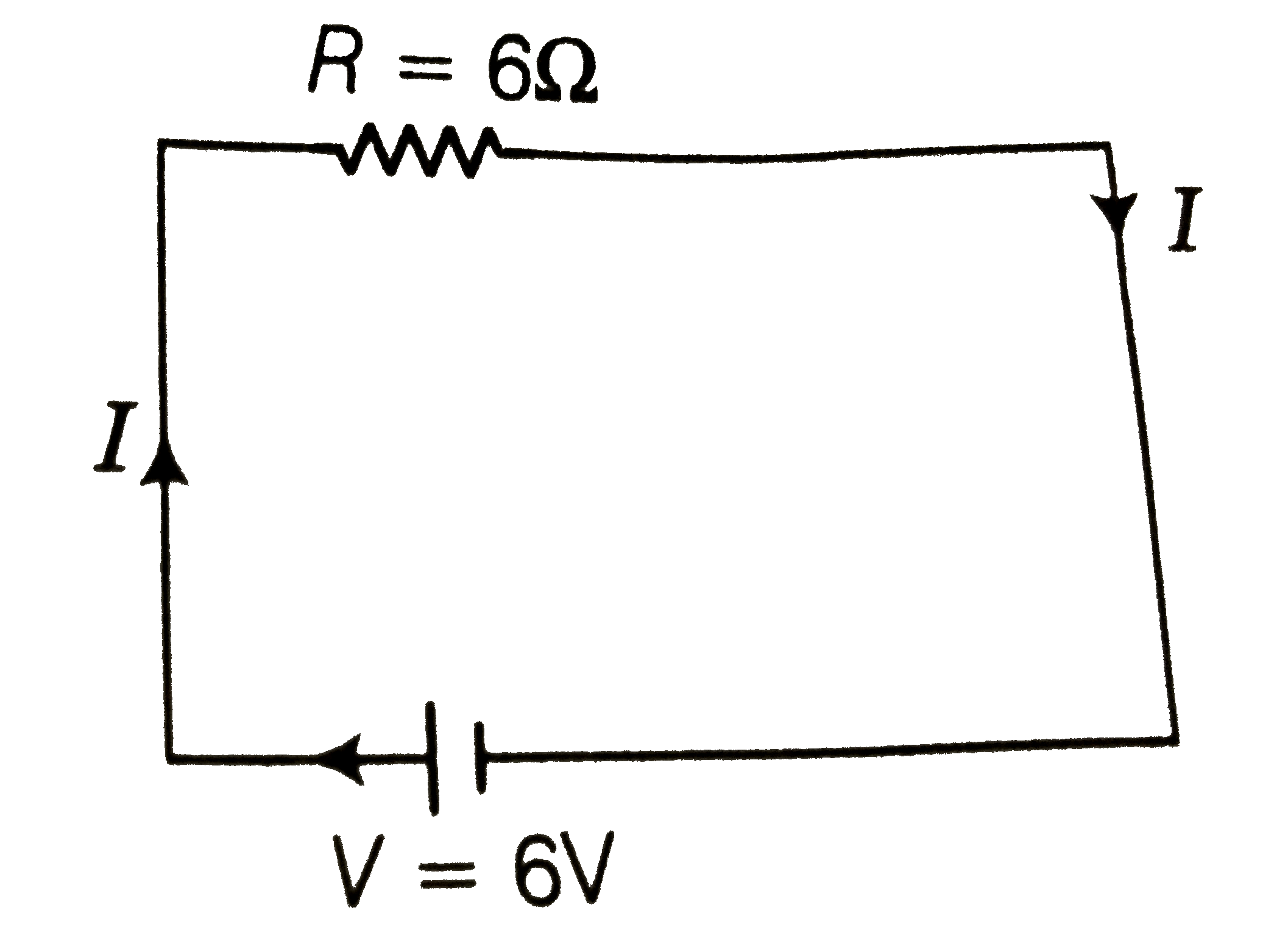Consider circuit in figure. How much energy is absorbed by electrons from the initial state of no current (ignore thermal motion) to the of drift velocity ?
 Solution in Gujrati
Solution in Gujrati
Current in the circuit I =
Number density of electron n =
Length of wire of circuit l = 10 cm = 0.1 m Area of cross section A =
Current due to electron moving with drift velocity,
Energy absorbed in form of K.E.,
K.E. = nAl
J
Topper's Solved these Questions
- BOOK - KUMAR PRAKASHANCHAPTER - CURRENT ELECTRICITYEXERCISE - SECTION [D] MULTIPLE CHOICE QUESTIONS (MCQs) (MCQs FROM .DARPAN. BASED ON TEXTBOOK)118videos
CURRENT ELECTRICITY
- BOOK - KUMAR PRAKASHANCHAPTER - CURRENT ELECTRICITYEXERCISE - SECTION [D] MULTIPLE CHOICE QUESTIONS (MCQs) (MCQs ASKED IN COMPETITIVE EXAMS)21videos
CURRENT ELECTRICITY
- BOOK - KUMAR PRAKASHANCHAPTER - CURRENT ELECTRICITYEXERCISE - SECTION C (SHORT ANSWER TYPE QUESTIONS )6videos
CURRENT ELECTRICITY
- BOOK - KUMAR PRAKASHANCHAPTER - BOARD'S QUESTION PAPER MARCH-2020 EXERCISE - PART-B SECTION -C4videos
BOARD'S QUESTION PAPER MARCH-2020
- BOOK - KUMAR PRAKASHANCHAPTER - DUAL NATURE OF RADIATION AND MATTEREXERCISE - Section-D (MCQs asked in GUJCET/Board Exam)1videos
DUAL NATURE OF RADIATION AND MATTER
Similar Questions
Electric current is ..... .
06:43View SolutionIn given circuit total power consumed is 150 W. Then value of R = ......
06:43View SolutionFirst a set of n equal resistors of R each are connected in series to a battery of emf E and internal resistance R. A current I is observed to flow. Then the n resistors are connected in parallel to the same battery. It is observed that the current is increased 10 times. What is 'n'?
06:43View SolutionDerive an expression for current I passing through an AC circuit containing only inductor L. Draw a Phasor diagram and graph of v and I versus ωt. Explain instantaneous power and the average power.
06:28View SolutionMass of photon in motion is ………
View Solution
(A) Consider circuit in figure. How much energy is absorbed by electrons from the initial state of no current (Ignore thermal motion) to the state of drift velocity?
(b) electrons give up energy at the rate of RI2 per second tot he thermal energy. What time scale would number associate with energy in problem (a)? n= number of electron/volume=1029m3 length of circuit=10cm, cross-section A=(1mm)204:24View Solution
(A) Consider circuit in figure. How much energy is absorbed by electrons from the initial state of no current (Ignore thermal motion) to the state of drift velocity?
(b) electrons give up energy at the rate of RI2 per second tot he thermal energy. What time scale would number associate with energy in problem (a)? n= number of electron/volume=1029m3 length of circuit=10cm, cross-section A=(1mm)201:49View SolutionConsider the circuit in the figure. (a) how much energy is absorbed by electrons from the initial state of no current (ignore thermal motion) to the state of drift velocity? (b) Electrons give up energy at the rate of Rl^(2) per second to the thermal energy. What time scale would the number associate with energy in problem (a)? n = number of electron/volume =10^(29)//m^(3) . Length of circuit = 10cm cross-section = A = (1mm)^(2) .
38:26View SolutionAn electron in a hydrogen atom in its ground state absorbs 1.5 times as much energy as the minimum required for it to escape from the atom. What is the velocity of the emitted electron?
03:12View Solution
(a). Consider circuit in figure. How much energy is absorbed by electrons from the initial state of no current (ignore thermal motion) to the state of drift velocity?
(b). Electrons give up energy at the rate of RI2 per second to the thermal energy. what time scale would number associate with energy in problem (a)? n=number f electron/volume=1029/m3. Length of circuit =10cm, cross-section=A=(1mm)2.02:41View SolutionDefine the term 'drift velocity' of electrons in a current carrying conductor. Obtain the relationship between the current density and the drift velocity of electrons.
06:24View SolutionWhat is the order of drift velocity of electrons?
01:58View SolutionDrift Of Electrons And Current In Terms Of Drift Velocity
09:01View Solution
(a). Consider circuit in figure. How much energy is absorbed by electrons from the initial state of no current (ignore thermal motion) to the state of drift velocity?
(b). Electrons give up energy at the rate of RI2 per second to the thermal energy. what time scale would number associate with energy in problem (a)? n=number f electron/volume=1029/m3. Length of circuit =10cm, cross-section=A=(1mm)2.02:18View SolutionDefine the term 'drift velocity' of electrons in a current carrying conductor. Obtain the relationship between the current density and the drift velocity of electrons.
06:16View Solution


